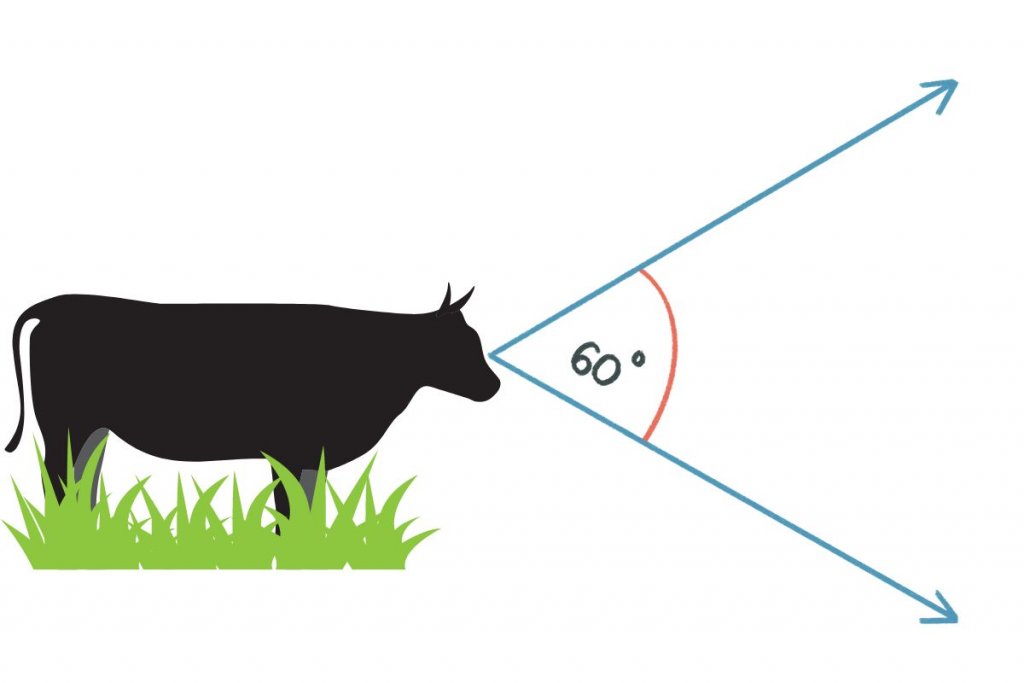While grazing on pasture, Cows can see things all around them in over a 300-degree range without moving their head. Their vision is limited when they raise their heads, creating a blind spot directly behind them.
Cows’ perception of light and different ranges of colors differ from ours. Cow’s night vision is significantly better than human vision.
Table of Contents
How A Cow’s Vision Works
Field Of Vision
Cows’ eyes located on the sides of their heads give them a field of vision of more than 300 degrees.
The much larger vision than that of humans gives cows a significantly smaller blind spot. When cows raise their head, the sides of their bodies create a blind spot directly behind them.

Cows’ main vision is monocular but they also have a limited binocular vision of 20-25 degrees.
Depth Perception
Cows have poor depth perception. They can’t tell how far they are from an object, even grass that is several feet ahead. The poor depth perception is caused by their 60 degrees of vertical vision.

Their oval-shaped pupils and weak eye muscles mean that they have a wide field of vision but they cannot focus quickly. For example, when a cow sees a shadow it can’t tell if it’s a pit filled with snake so it will hesitate to move.
When foraging, cows substitute their lack of depth perception with whiskers that help them to avoid bumping their chin on the ground.
Color Perception
Cows are dichromatic organisms. Dichromacy is the state of having two types of functioning color receptors (cones) in the eyes. Dichromats match any color they see with a mixture of not more than two pure spectral lights.
Cows have two color receptors in their retinas – yellow and blue.
There is a misconception that cows are colorblind. They are not. Cows can see shades of yellow, black, white, grey, brown, and blue.
Another misconception is about what happens in bullfighting. That when a matador waves a red cape, it’s the color of the cape that attracts the bull. This is not true because cows lack the red color receptors in their eyes’ retinas. It’s the motion of the cape that attracts the bull.
Light Sensitivity
Cows react to light levels differently than we do; they prefer to move from low-light areas to well-lighted areas. It’s best to use diffused lights within because it doesn’t have the intensity or glare of direct light, nor does it cast harsh shadows.
Flight Zone
A flight zone is a cow’s circle of safety so if anything enters its flight zone it will move.
The flight zone of a cow is its personal safe space and can increase when:
- Cows are approached from the head
- Cows are excited
- Cows are worked on a horseback
- Dealing with less tame cattle
Cows have different flight zones for humans and dominant cows in their herd. A dairy cow that is used to interacting with people has a small flight zone than a beef cattle with little to no human interaction.
Colors Cattle Can and Can’t See
Cows are better at discerning colors of long wavelengths but struggle to differentiate colors of short wavelengths.
| Can see | Yellow, blue, brown, grey, white, and black |
| Can’t see | Red and green |
As mentioned earlier, cows have yellow and blue color receptors. So to cows, red and green are shades of brown, while yellow colors and purple colors are shades of blue color. Other farm animals such as dogs and horses have the same colorblindness.
How Do Cows See In The Dark?
Cows’ ability to see in the dark is enabled by the tapetum lucidum. The tapetum lucidum is a layer of tissue that lies behind the retina. It reflects light back through the retina, enabling them to see even in low-light circumstances.
A cow’s ability to see at night is a necessity for two reasons:
- To find food
- To see predators
When you shine a bright light in front of a cow’s eyes, the tapetum lucidum makes the cow’s eyes seem like they are glowing, a phenomenon that is commonly known as ‘eyeshine’.
Cows are warm-blooded animals so it’s impossible for them to see infrared. Their bodies are warm and thus emit infrared light.
